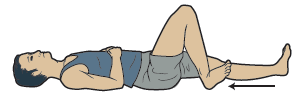This information describes Level 1 of an exercise program. This program will help you before and after your stem cell transplant, and during your recovery.
These exercises use the major muscle groups that you use for everyday activities. It will help prevent you from feeling stiff and decrease the effects of bed rest and not being able to move. Your physical and occupational therapists will help guide you through the program.
Exercise Tips
- Dress comfortably. You should wear clothing that won’t limit your movements. You can wear a hospital gown, pajamas, or athletic clothing.
- Don’t hold your breath while doing any of these exercises. Count out loud during the exercises to keep your breaths evenly paced.
- Stop any exercise that causes you pain or discomfort and tell your physical or occupational therapist. You can continue to do the other exercises.
Exercises
Ankle circles
- Lie on your back or sit up.
- Rotate your right ankle clockwise (to the right) 10 times (see Figure 1).
- Switch directions and rotate your ankle counter-clockwise (to the left) 10 times.
- Repeat the exercise with your left ankle.

Figure 1. Ankle circles
Ankle pumps
- Lie on your back or sit up.
- Point your toes up toward your nose. You can do this with both feet at the same time.
- Then point your toes down to the floor (see Figure 2).
- Repeat 10 times.

Figure 2. Ankle pumps
Quadriceps sets
- Lie on your back or sit with your legs straight out in front of you.
- Push the back of your knees down into the bed or floor while tightening the muscles on the top of your thigh (see Figure 3).
- Hold this position and count out loud for 5 seconds. Then loosen the muscles.
- Repeat 10 times.

Figure 3. Quadriceps sets
Gluteal sets
- Lie on your back or sit up.
- Squeeze your buttocks together to tighten the muscles (see Figure 4).
- Hold this position and count out loud for 5 seconds. Then loosen the muscles.
- Repeat 10 times.

Figure 4. Gluteal sets
Abductor strengthening exercise
- Lie on your back with your legs straight, and your toes pointed up to the ceiling.
- Keeping your toes pointed up to the ceiling, slide your left leg out to the side (see Figure 5).
- Return to the starting position.
- Repeat 10 times.
- Repeat the exercise with your right leg.

Figure 5. Abductor strengthening exercise
Heel slides
- Lie flat on your back with your legs straight. You can wear socks during this exercise if they make you more comfortable.
- Gently slide your right heel toward your buttocks (see Figure 6).
- Return to the starting position.
- Repeat 10 times.
- Repeat with your left leg.

Figure 6. Heel slides
Seated abductor strengthening with elastic bands (Thera-bandTM)
- Sit in a chair with your back supported and your feet flat on the floor.
- Loop the elastic band around your thighs.
- Move your knees apart, pressing into the elastic band (see Figure 7).
- Slowly return to the starting position.
- Repeat 10 times.

Figure 7. Seated abductor strengthening with elastic band
Seated pillow squeezes
- Sit in a chair with your back supported and your feet flat on the floor.
- Place a pillow between your knees.
- Press your knees into the pillow (see Figure 8).
- Hold this position and count out loud for 5 seconds. Release the hold.
- Repeat 10 times.

Figure 8. Seated pillow squeezes
Sitting kicks
- Sit in a chair with your back supported and your feet flat on the floor.
- Kick your right foot up until your leg is straight (see Figure 9).
- Hold this position and count out loud to 5.
- Lower your foot to the floor.
- Repeat 10 times.
- Repeat the exercise with your left leg.

Figure 9. Sitting kicks
